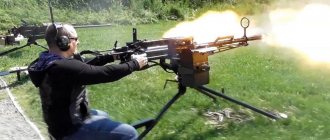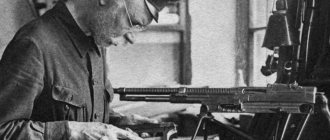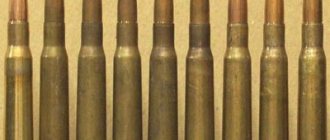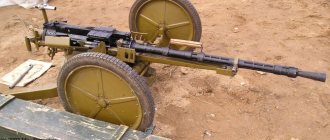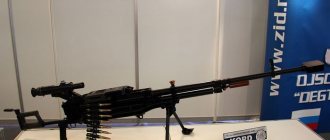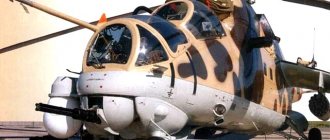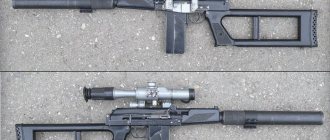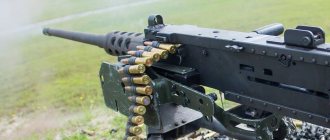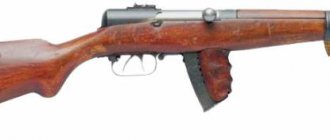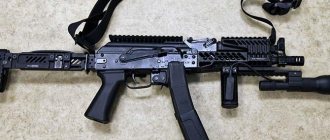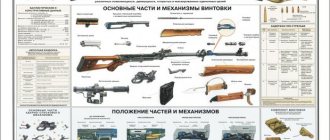The outstanding gunsmith Semyon Vladimirov managed to combine the rate of fire of a conventional heavy machine gun with the armor-piercing power of an anti-tank rifle, providing the new weapon with the ability to fight both manpower located in light shelters and lightly armored targets and enemy fire weapons. Moreover, the KPV coped well with the task of covering units from low-flying aircraft, also as an anti-aircraft machine gun.
The most powerful mass-produced machine gun in the world can safely be called the Soviet KPV - the Vladimirov heavy machine gun (GAU Index - 56-P-562), which was developed in 1944 by the outstanding Soviet small arms designer Semyon Vladimirovich Vladimirov. The new 14.5 mm mounted heavy machine gun KPV was put into service already in 1949.
The muzzle energy of the KPV machine gun reaches 31 kJ (for comparison, the American 12.7 mm Browning M2HB machine gun has only 17 kJ, and the Soviet 20 mm ShVAK aircraft gun has about 28 kJ). Along with the German MG 151, Czechoslovak ZB-60 and Chinese QJG-02 machine gun, the Vladimirovna heavy machine gun is one of the most powerful machine guns on the planet ever mass-produced and used directly by the armed forces for combat operations.
KPV (PKP) on a Kharykin wheeled machine
At the very beginning of its operation, the Vladimirov machine gun was also called PKP (large-caliber infantry machine gun) and was installed on Kharykin’s wheeled machine; already at that time it was the most powerful machine gun on the planet!
KPV 14.5 mm heavy machine gun in the Museum of Russian Military History in Padikovo, Istrinsky District, Moscow Region
Nowadays it is quite rare to find photographs of this version of the KPV on the Internet, but domestic small arms museums still contain similar examples of the most powerful machine gun in the world!
KPV machine gun trigger (@ Yuri Pasholok yuripasholok.livejournal.com)
KPV machine gun on Kharykin's wheeled machine (@ Yuri Pasholok yuripasholok.livejournal.com)
Such a copy of the KPV on a Kharykin wheeled machine is exhibited at the Museum of Russian Military History in the village of Padikovo, Istrinsky district, Moscow region, which can be reached from Moscow along the Novorizhskoe highway.
Interesting Facts
During combat operations, the KPVT tank machine gun showed such high armor-piercing ability against RHA steel armor of the NATO standard that starting in the 1970s. and to this day NATO countries, issuing those. assignment for the design and creation of new military equipment, taking into account the damaging effect of an armor-piercing bullet fired from a KPVT!
And this is not surprising, since at distances from 500 to 800 m the KPVT confidently penetrated the frontal armor of the main types of armored personnel carriers of a potential enemy. The most common armored personnel carrier M113 (USA) was also under threat of defeat.
Based on this penetrating ability, the combat weight of the main NATO infantry fighting vehicles “Marder A3” (Germany) and “M2A2 Bradley” (USA), relative to Russian infantry fighting vehicles, was doubled.
ZGU-1 - KPV in anti-aircraft design
ZGU-1 consists of a modernized 14.5-mm KPVM machine gun, a lightweight carriage and sighting devices. This anti-aircraft gun is designed to destroy air targets flying at speeds of up to 200 m/s at a range of up to 2000 and an altitude of up to 1500 m.
ZGU-1 - 14.5mm anti-aircraft machine gun mount
During the war in Afghanistan, it was used by both sides against air targets and ground targets (lightly armored vehicles, vehicles, manpower). To control the fire of the ZGU-1, the VK-4 anti-aircraft collimator sight is used.
ZGU-1 - Soviet anti-aircraft single mountain-pack machine gun mount during the war in Afghanistan
Device design
The CPV consists of the following main parts:
- Trunk;
- Receiver;
- Gate;
- Recoil spring;
- Receiver cover;
- Receiver;
- Trigger;
- Butt pad.
The set of accessories for the machine gun also includes:
- Cartridge boxes and tapes;
- Optical sight;
- Set for disassembly, assembly and cleaning;
- Cold sighting tube;
- Devices for firing blank cartridges;
- Devices for equipping the tape.
The KPVT is additionally equipped with an electric trigger and a pneumatic reloading mechanism.
Modern poster of the Russian Army
ZPU-2 - twin KPV in anti-aircraft design
The ZPU-2 14.5 mm anti-aircraft twin mount was put into service in 1949, its serial production was launched at Plant No. 525.
ZPU-2 (GAU index - 56-US-562) - Soviet twin anti-aircraft machine gun in stowed position
The 14.5 mm ZPU-2 can be used to engage air targets (airplanes, helicopters, drones, as well as enemy airborne units), as well as it can be used to fire at lightly armored vehicles and concentrations of manpower.
ZPU-2 14.5 mm - Soviet twin anti-aircraft machine gun mount in combat position
The relatively light weight and the presence of a pair of wheels allows this anti-aircraft gun to be moved over short distances by a crew consisting of 6 people.
Features of the machine gun
The machine gun has several important features compared to its predecessors:
Firstly, this is the design. It is fundamentally new, with new engineering solutions and design developments
Thanks to these innovations, the machine gun has less weight; The developers of the machine gun paid much attention to such a component as the “percussion mechanism”. It is much stronger, which makes it possible to shoot at a high rate, and the recoil has become less; New technologies were used in the manufacture of the barrel, which made it possible to obtain a durable alloy
Now the barrel has minimal distortion, and the percentage of shooting accuracy has increased.
The machine gun is equipped with a pistol grip
ZPU-4 - quad anti-aircraft KPV
ZPU-4 is a quad 14.5 mm anti-aircraft machine gun mount, which is designed to engage air targets at an altitude of up to 1,500 meters and a range of up to 2,000 meters. The weight of the ZPU-4 anti-aircraft gun is 2100 kilograms. The total rate of fire is 2400 rounds per minute, 600 rounds per minute per barrel of KPV machine guns.
ZPU-4 - quad 14.5-mm anti-aircraft machine gun mount for KPV machine guns
The ZPU-4 installation was actively used during the Korean War (by North Korean and Chinese troops), as well as during the Gulf War (by the Iraqi armed forces). Currently, ZPU-4, installed in the back of trucks, is used by the Syrian government army against terrorist groups.
ZPU-4 - quad 14.5 mm anti-aircraft machine gun mount in firing position
In the Armed Forces of the Russian Federation, ZPU-4 anti-aircraft mounts have been replaced by more powerful twin ZU-23-2 artillery mounts, 23 mm caliber.
History of the creation of the Kord machine gun
To date, the Kord heavy machine gun is still the latest development in the line of combat Soviet (Russian) machine guns, the history of which dates back to the Second World War.
During the 70-80s, the NSV 12.7 Utes heavy machine gun was used in the USSR Armed Forces. The machine gun was good for fighting armored vehicles, infantry in large numbers, and airplanes and helicopters flying at low altitudes.
Machine gun "Utes", predecessor of the machine gun "Kord"
After the collapse of the USSR, the factory workshops for the production of NSV machine guns remained outside of Russia - in Kazakhstan. Therefore, the issue of developing and producing its own heavy machine gun has become urgent for the Russian Armed Forces.
Plant named after Degtyarev (ZiD) was supposed to create a new small arms machine gun that would use a 12.7*108 mm cartridge. The terms of reference required that the machine gun could be fired from the ground, the ability to be mounted on trucks or as an anti-aircraft gun, but with a higher rate of fire.
Photo of the plant named after. Degtyarev, where the Kord machine gun was developed
Weapon development began in the very early 90s:
- 1997 – the first copies were manufactured for field testing;
- 1998 – admission to the RF Armed Forces;
- Since 2001, industrial production of machine guns began.
Shooting from a machine gun at the exercise "West"
MTPU - 14.5 mm naval machine gun mount
The 14.5-mm MTPU naval pedestal machine gun mount is designed to combat surface, coastal and airborne lightly armored targets - a fairly powerful weapon for the defense of small ships.
The MTPU is installed on the decks of warships and boats on a carriage, and ensures the destruction of surface and coastal targets at ranges of up to 2000 m at an altitude of up to 1500 m. For firing, the MTPU uses 14.5 mm cartridges with an armor-piercing incendiary bullet B-32, armor-piercing - BZT tracer bullet and MDZ instant incendiary bullet.
Machine gun cartridges
The cord fires 12.7mm bullets.
Two types of bullets are used:
- incendiary-tracer;
- armor-piercing incendiary.
The machine gun can be equipped with any standardized 12.7*108 mm bullets, these are:
- B-32;
- BZT-44;
- MDZ;
- BS-41.
Cartridge 12.7*108 mm
Characteristics of the 12.7*108 mm cartridge:
| Bullet diameter, mm | 12,98 |
| Neck diameter, mm | 13,95 |
| Shoulder diameter, mm | 18,9 |
| Base diameter, mm | 21,75 |
| Rim diameter, mm | 21,7 |
| Rim thickness, mm | 1,9 |
| Case length, mm | 108 |
| Total length, mm | 147,5 |
| Volume, cm3 | 22,72 |
| Maximum pressure, MPa | 360 |
| Ballistic performance | API B32 |
| Bullet weight, g | 48,3 |
| Speed, m/s | 820 |
| Energy, J | 16240 |
| Bullet weight, g | 55,4 |
KPVT - for installation on armored vehicles
KPVT (GRAU index - 56-P-562T) is a modified version of the infantry heavy machine gun of the same name for arming armored vehicles. The KPVT tank machine gun can be used both for firing at ground (armored vehicles, armored personnel carriers, infantry fighting vehicles, anti-tank artillery) or surface targets (boats and light-engine vessels), and for hitting low-flying enemy aircraft, helicopters and UAVs.
In the KPVT large-caliber machine gun, the automation implements the principle of using recoil energy with a short barrel stroke, that is, using the recoil of a movable barrel, with which the bolt is firmly coupled during the shot. In this case, when fired, not just the bolt is thrown back, but the barrel along with the bolt.
3D model of the KPVT machine gun on the T55 tank (@ Live Resin 3D)
The KPVT machine gun provides effective destruction of targets at a distance of up to 2 kilometers, but experienced shooters can fire quite effectively at targets at a longer distance (after all, 14.5 × 114 mm ammunition retains lethality at a range of up to 4,000 meters), depending on the level of skill, the quality of the ammunition used and the degree of wear of the machine gun barrel.
Principle of operation
The Kord heavy machine gun is an automatic weapon with belt-fed cartridges.
Moreover, it is double-sided, that is, the belt with ammunition is fed to the receiver both on the left and on the right. The machine gun version, which is designed to support infantry, uses 50-round belts, and tank modifications are equipped with 150-round belts. The operation of the machine gun is based on the gas-operated principle, in which a gas piston with an extended stroke is located below the barrel. The machine gun barrel is removable and is cooled by air flow.
The barrel is locked by turning the bolt cylinder and engaging the lug lugs of the cylinder with the lug lugs of the barrel. The ammunition is fed from a metal belt with an open link. The cartridges are fed from the belt directly into the barrel of the machine gun. Moving a little away from words, let's move on to numbers, to the performance characteristics of the cord.
T-90 tank equipped with a Kord machine gun
Tactical and technical characteristics of the KPVT 14.5 mm machine gun
The Vladimirov Tank Heavy Machine Gun has truly impressive performance characteristics and is rightfully considered the most powerful machine gun in the world:
- History of production and service - Developed: 1944 - Designer: Vladimirov, Semyon Vladimirovich - Adopted for service: 1949 - Manufacturer: Degtyarev Plant (Kovrov), (Kuibyshev)
- KPV machine gun weight - 52.3 kg (without ammunition)
- Machine gun dimensions - Length, mm: 2000 - Barrel length, mm: 1346
- The caliber of the KPV machine gun is 14.5 mm
- The rate of fire of the KPV machine gun is 550-600 rounds/min.
- Bullet speed - 976-1005 m/s
- The sighting range of the KPV machine gun is 2000 meters (1500 for air targets)
- Operating principles: - short barrel stroke, rotary bolt
- Type of ammunition: - 40-round belt
Main modifications
6P49. Installed on tank armor or other vehicles. The machine gun is equipped with an electric start, the main purpose is to shoot and destroy aircraft and helicopters flying at low altitudes, as well as “work” on cars, trucks, armored vehicles with little armor and large concentrations of infantry.
Machine gun "Kord". Modification 6P49
Machine gun characteristics:
| Length, mm | 1625 |
| Width, mm | 136 |
| Height, mm | 215 |
| Weight, kg | 27 |
6P50. It is in service with infantry and motorized rifle formations. The main task in this use case is to support offensive or defensive infantry actions.
Machine gun "Kord". Modification 6P50
Machine gun characteristics:
| Length, mm | 1580 |
| Width, mm | 135 |
| Height, mm | 215 |
| Weight, kg | 25 |
6P50-1. This is a variety for infantry. Used as a universal machine gun. The machine gun is mounted on a 6T19 machine, which includes a bipod, butt and pistol grip.
Machine gun "Kord". Modification 6P50-1
Machine gun characteristics:
| Length, mm | 1980 |
| Width, mm | 450 |
| Height, mm | 500 |
| Weight, kg | 32 |
6P50-2. Wheeled and tracked vehicles are equipped with this type of weapon. The 6U16 machine is a holding mechanism with two boxes of cartridges.
Machine gun "Kord". Modification 6P50-2
Machine gun characteristics:
| Length, mm | 1980 |
| Width, mm | 810 |
| Height, mm | 450 |
| Weight, kg | 52 |
6P50-3. Additionally, the 6P50-3 modification kit includes a 6U16 installation and the machine gun rack itself. Depending on the position the fighter takes when shooting, the stand can be adjusted in height.
Machine gun "Kord". Modification 6P50-3
Machine gun characteristics:
| Length, mm | 1980 |
| Width, mm | 810 |
| Height, mm | 1600 |
| Weight, kg | 75 |
6P51. The main difference between this modification and others is that the cartridges are fed into the receiver on the left. Can be used in conjunction with right-hand fed machine guns both on land and on ships.
Machine gun characteristics:
| Length, mm | 1625 |
| Width, mm | 135 |
| Height, mm | 215 |
| Weight, kg | 27 |
Range of 14.5 × 114 mm cartridges for the KPV / KPVT machine gun
The first version of the 14.5 mm cartridge (with an armor-piercing bullet with a steel core and a brass sleeve) was developed in the USSR back in 1938 as ammunition for the Rukavishnikov anti-tank rifle.
Serial production of the modified 14.5 mm cartridge began in 1941, and on July 16, 1941, the modified cartridge with an armor-piercing incendiary bullet with a hardened steel core was adopted by the Red Army under the designation “14.5 mm B-32 cartridge.” On August 15, 1941, the second version of the cartridge with an armor-piercing incendiary bullet with a carbide-metal-ceramic core was adopted for service under the name “14.5-mm cartridge with a BS-41 bullet.” Nomenclature of cartridges for the KPV / KPVT machine gun
| Cartridge | GRAU index | Note |
| 14.5 B-32 hl | 57-BZ-561 | cartridge with an armor-piercing incendiary bullet B-32 with a steel core and a brass sleeve |
| 14.5 B-32 gs | 57-BZ-561S | cartridge with an armor-piercing incendiary bullet B-32 with a steel core and a steel sleeve |
| 14.5 BZT hl | 57-BZT-561 | cartridge with an armor-piercing incendiary tracer bullet BZT-44 with a steel core and a brass sleeve |
| 14.5 BZT gs | 57-BZT-561S | cartridge with an armor-piercing incendiary tracer bullet BZT-44 with a steel core and a steel sleeve |
| 14.5 BZT-M gs | 57-BZT-561SM | cartridge with an armor-piercing incendiary tracer bullet BZT-M with a steel core and a steel sleeve |
| 14.5 BS-39 | cartridge with armor-piercing bullet BS-39 with a steel core | |
| 14.5 BS-41 | 57-BZ-562 | cartridge with armor-piercing incendiary bullet BS-41 with a metal-ceramic core (tungsten carbide) |
| 14.5 BST | 57-BZT-562 | cartridge with armor-piercing incendiary tracer bullet BST |
| 14.5 MDZ gl | 57-З-564 | cartridge with instantaneous incendiary bullet MDZ and brass sleeve |
| 14.5 MDZ gs | 57-З-564С | cartridge with instantaneous incendiary bullet MDZ and steel sleeve |
| 14.5 MDZ | 7-З-1 | cartridge with instantaneous incendiary bullet MDZ |
| 14.5 MDZ-M | 7-З-6 | instantaneous incendiary bullet cartridge MDZ-M |
| 57-З-561М | cartridge with sighting and incendiary bullet ZP | |
| 57-N-561UCH | training cartridge | |
| 57-Х-561 | blank cartridge |
In 1943, a number of technological processes for the production of cartridges of this caliber in the USSR were automated, which made it possible to significantly increase the production of 14.5-mm cartridges for PTRS and PTRD anti-tank rifles, which were still a relevant means of combating enemy armored vehicles on the battlefields of the Second World War.
Chuck dimensions 14.5 × 114 mm for KPV (KPVT)
In 1944, the 14.5 × 114 mm cartridge became ammunition for the new KPV heavy machine gun and its modification KPVT, which were installed on Soviet armored vehicles (from the BRDM-2 and BTR-60PB to the later BTR-80), and were also used in twin and quad anti-aircraft machine gun installations.
Machine gun belt equipment for KPV (KPVT) 14.5 mm
After the end of World War II, this large-caliber cartridge was adopted by the armies of the Warsaw Pact countries and its production was established in the USSR and Bulgaria. At the end of the 20th century, the development of large-caliber sniper rifles with special power and armor penetration, capable of hitting targets even inside lightly armored vehicles and behind cover, began with the 14.5x114 mm cartridge. Until now, the KPVT is the most powerful machine gun of all mass-produced on the planet!
Modifications
KPVT-1
A number of improvements have been made to the design, in particular, the ability to switch the direction of feed of the tape from right to left has been added, which is done by rearranging the parts of the feed mechanism and makes it easier to install the machine gun on various types of armored vehicles.
Infantry options
Since the infantry version of the Vladimirov heavy machine gun on a wheeled machine was withdrawn from service and replaced by other types of small arms, and the KPVT remained and continues to remain in service with the armies and ground components of the navies of many states in the post-Soviet space, as well as foreign countries, where it was delivered en masse or where Soviet-style armored vehicles were produced, through reverse engineering and technical conversion by military personnel, the KPVT is converted into an infantry version on a machine or on a tripod to strengthen the fire system of tactical units in the defense.

